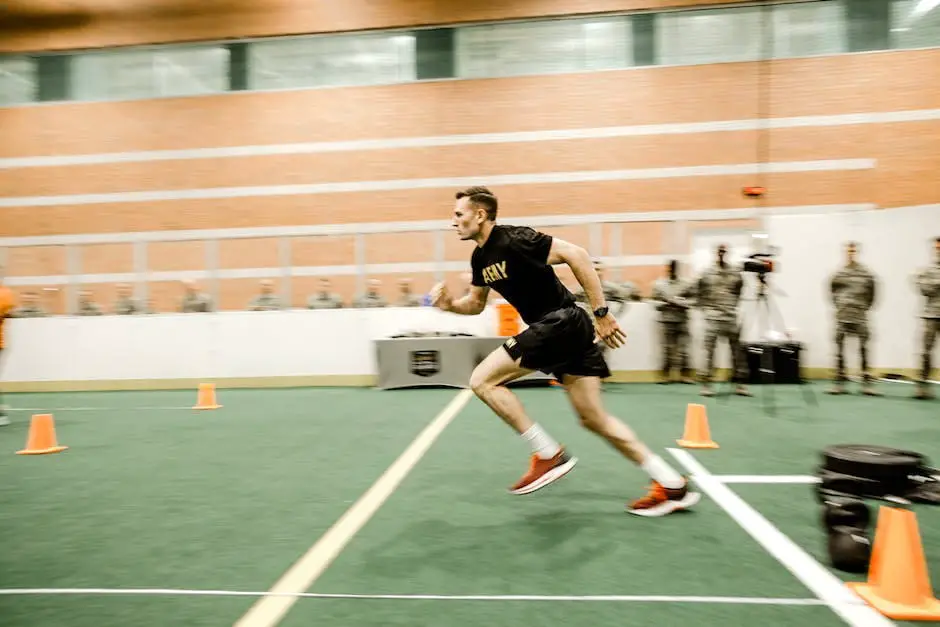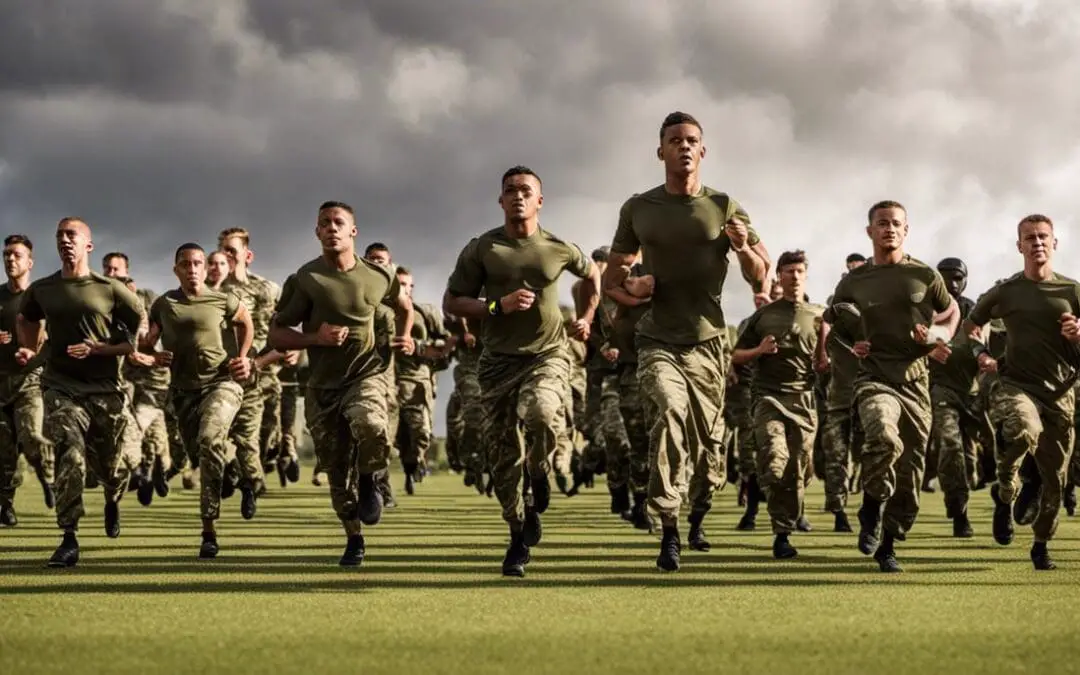Physical fitness, particularly cardiovascular stamina, is an integral part of successful service in the United States Army, and it is allied with endurance, strength, and agility. To pass the Army’s demanding Physical Fitness Test (APFT), which has a significant reliance on cardio, one must cultivate a profound understanding of this test’s framework, the particular cardiovascular exercises involved, and the criteria for accomplishment. Also, it is essential to comprehend cardiovascular basics and principles, which comprises understanding heart rate, aerobic vs anaerobic exercise, cardio endurance, plus the benefits of regular cardio-oriented workouts. This narrative will delve into accessible yet effective cardio training methodologies tailored to improve endurance and stamina uniquely. Furthermore, we will discuss the process of fashioning a workout routine that will exploit your cardiovascular aptitude to the maximum, all with a prime objective- passing the Army Physical Fitness Test. Lastly, we will underscore the critical role of recovery and nutrition in cardio training, which encompasses muscle regeneration, hydration, a well-balanced diet, and a good sleep regimen- all indispensable to physical fitness.
Understanding the Army’s Physical Fitness Test
Understanding the Army’s Physical Fitness Test: The Basics
The Army’s Physical Fitness Test (APFT) is designed to test the physical endurance and cardio-respiratory fitness of soldiers in three primary spaces: push-ups, sit-ups, and a timed two-mile run. Each of these tasks is given a score, and the combined total determines whether a soldier passes. The test is also adjusted for age and gender, so the standards for passing vary.
The Cardio Component: The Two-Mile Run
Of the three components of the APFT, the two-mile run is the primary task measuring cardio fitness. This event is designed to test your aerobic fitness and the endurance of your leg muscles. You will be scored based on the time it takes to complete the two-mile course. For instance, to score the maximum of 100 points for this event, a male in the age group of 17-21 needs to complete the run in less than 13 minutes and a female in the same age group needs to complete it under 15 minutes and 36 seconds.
Standards for Passing the APFT
For soldiers to pass the Army’s physical fitness test, they need to score at least 60 points in each event. Thus, the minimum total score is 180 out of a possible max of 300. That means to pass the cardio or two-mile run, soldiers have to finish within a certain amount of time that corresponds with at least 60 points for their age and gender group.
Training for the APFT
To improve cardio for the APFT, incorporate a mixture of running, walking, and sprinting. Start by setting a two-mile pace you feel comfortable with, and gradually try to increase your pace. Do interval training by adding short spurts of speed or sprints followed by recovery periods. This will increase your stamina and improve your cardiovascular fitness over time.
Cardio-related Exercises for Preparing for the APFT
In addition to running, other cardio-related activities can play a vital part in preparing for the Army’s physical fitness test. Exercises like swimming, cycling, and stair climbing can also help build endurance and stamina. These low-impact workouts give your joints a break from the repetitive pounding they get from running while still boosting your cardio fitness.
Tips for Improving APFT Score
To increase your chances of passing the APFT, especially the run, train in conditions similar to those of the test. Running on a flat surface is different from running on a hilly one, and a treadmill is not the same as the great outdoors. Understanding your pace and managing your energy throughout your run is also crucial for success. Work on your breathing technique and try to maintain a steady rhythm of inhaling and exhaling.

Cardiovascular Basics and Principles
Understanding Cardiovascular Health
Cardiovascular health refers to the wellness and efficiency of the heart, the network of blood vessels, and the blood itself. The key to good cardiovascular health is the heart’s ability to pump oxygen-rich blood to the body’s tissues and organs effectively. The cardiovascular system is integrally involved in maintaining overall health and wellness, with its reach extending to all bodily functions.
Heart Rate and Cardio Exercise
Heart rate, or the number of times your heart beats per minute, is a crucial measure in cardiovascular exercise. It is an excellent indicator of your cardio fitness level. The American Heart Association suggests an ideal target heart rate range during moderate to intense exercise to be 50% to 85% of your maximum heart rate, which can be estimated as 220 minus your age.
Aerobic and Anaerobic Exercise
In discussing cardiovascular fitness, it is essential to distinguish between aerobic and anaerobic exercise. Aerobic exercise, including activities such as running and biking, uses oxygen to fuel your muscles over longer periods of exercise, thus improving your cardiorespiratory fitness. Anaerobic exercise, on the other hand, includes intense, short bursts of activity without relying on oxygen as a fuel, such as sprinting or lifting heavy weights. While both forms of exercise promote distinct health benefits, aerobic activity is typically recommended for improving cardiovascular health.
Cardio Endurance
Cardiovascular endurance refers to the body’s ability to sustain prolonged periods of dynamic, whole-body exercise at moderate to high levels of intensity. It is a measure of how effectively your heart and lungs work together to supply oxygen and nutrients to your muscles during exercise. By regularly engaging in cardio activities such as walking, swimming, or cycling, you can cultivate greater cardio endurance, which is a critical component in army physical fitness.
Benefits of Cardio Workouts
Cardio workouts provide numerous health benefits beyond cardiovascular fitness. Regular cardiovascular exercise can aid in weight management, improve lung capacity, boost mood and energy levels, enhance sleep quality, and even bolster immune function. It also reduces the risk of developing various health problems, including heart disease, hypertension, type 2 diabetes, and certain types of cancer. For army personnel, maintaining high cardiovascular fitness is not only beneficial to their health but also essential for optimal mission performance.

Cardio Training Techniques
Understanding Cardio Training Techniques
Cardio training is a critical component of physical fitness, which involves raising your heart rate and increasing blood flow, thereby improving your cardiovascular health. This type of training is essential for individuals preparing for army physical fitness tests, as it boosts stamina and endurance.
Interval Training
One effective strategy for cardio training is interval training. This technique involves alternating between periods of intense exertion and periods of rest or lower-intensity exercise. For instance, you might sprint for 30 seconds, walk for one minute and then repeat the cycle throughout your workout. This technique can be very beneficial for boosting cardiovascular fitness, as it pushes your heart rate up quickly, initiating cardiovascular adaptations.
Circuit Training
Circuit training is another effective cardio training strategy. This training method involves performing a series of exercises (usually six to ten) targeting different muscle groups with minimal rest between each exercise. An example of a circuit could be push-ups, jump rope, lunges, pull-ups, and plank, each done for a certain interval or rep count before swiftly moving on to the next exercise. This type of training helps to develop both strength and cardiovascular endurance as you’re essentially combining resistance training with high-intensity cardio.
Progressive Overload Principle
The progressive overload principle is one of the fundamental methods for increasing stamina and endurance. This method involves gradually increasing the intensity or duration of your workouts over time. The idea is to keep challenging your body to adapt to increasing demands. For instance, if you run three miles in 30 minutes, over time, you could aim to run the same distance in less time, or run a greater distance in the same amount of time. Regularly pushing your boundaries improves your cardiovascular strength and endurance.
Incorporating These Techniques
To effectively incorporate these cardio training techniques, you could create a weekly schedule that involves different types of training on different days. Ensure that you allocate at least one day a week for rest and recovery. For instance, you might do interval training on Mondays, circuit training on Wednesdays, and a longer run incorporating progressive overload principles on Fridays.
Remember, the key to successful cardio training is consistency and gradual progression, so be patient, keep at it, and your stamina and endurance will gradually improve.

Creating a Cardio Workout Routine
Understanding the Army Physical Fitness Test (APFT) Requirements
The Army Physical Fitness Test (APFT) consists of three events: push-ups, sit-ups, and a timed two-mile run. The scoring is based on age, gender, and the amount of time taken or number of repetitions made. However, for an optimal cardio workout routine, you should focus on the two-mile run. This part of the test will measure the strength of your cardiovascular system and aerobic endurance.
Crafting a Cardio Workout Routine
Begin your cardio workout with five to ten minutes of warm-up, which can include light jogging, dynamic stretches, or calisthenics. This will properly prepare your muscles for the workout ahead, reducing the risk of injury.
For the main workout, focus on running. Start with a distance that you can comfortably cover and aim to increase this gradually over time. When you start, a distance of one to two miles at a light to moderate pace might be appropriate. Increase this by about 10% per week, but listen to your body and ensure you’re not pushing too hard.
In addition to consistent running, add interval training into your routine. One example of interval training is sprinting for 30 seconds, then jogging or walking for 60 seconds, cycling this pattern for about 20 minutes. Interval training helps to improve aerobic capacity and endurance quickly, both of which are crucial for the APFT.
Incorporation of Strength Training
Because the APFT also includes push-ups and sit-ups, your workout routine should not neglect strength training. Incorporate at least two days of strength training into your weekly routine to improve your overall fitness level.
Importance of Rest Days
Rest days are critical in any workout routine. They give your body time to recover, adapt and grow stronger. Ensure that you are taking at least one rest day per week. This also helps avoid overuse injuries.
Sustaining the Right Diet
A successful cardio workout routine isn’t just about the exercise. It’s also about maintaining a healthy diet. Ensure you’re getting plenty of lean proteins, fruits, vegetables, and complex carbs. Hydrate adequately before, during and after your workouts.
Regular Check-in with Your Progress
Remember to keep a record of your progress. Keeping track of how far and how long you ran, how many intervals you did, and how you felt can help monitor your improvement over time, and can provide motivation to keep pushing forward.
By following these steps and staying consistent, your cardiovascular system will grow stronger, preparing you for the Army Physical Fitness Test. Remember to always consult with a fitness professional or a physical therapist to prevent injuries, especially if you’re new to running or cardio workouts.

Recovery and Nutrition
Understanding the Importance of Recovery and Nutrition in Cardio Training
A crucial element of maintaining good cardiovascular health and training for the army physical fitness is understanding the importance of recovery and nutrition. Achieving a balance between training hard and allowing enough time for your body to recover can maximize your overall health and performance. Ensuring balanced nutrition can also fuel your training and maintain your overall body function.
Muscle Recovery in Cardio Training
After physical exercise or training, your body naturally goes into a period of recovery. This recovery period is important for reducing the possibility of injury, among other things. Muscle recovery after cardiovascular training is crucial for rebuilding and strengthening your muscles. Incorporating post-workout recovery techniques, such as stretching, foam rolling exercises, and low-intensity activities like walking or cycling, can help improve muscle recovery. Careful attention to the signs of overtraining, such as increased fatigue, decrease in performance, disrupted sleep, or heightened heart rate, should also be considered, and appropriate recovery time should be scheduled accordingly.
The Role of Hydration in Physical Fitness
Staying hydrated before, during, and after training sessions is essential for cardio health, and thus, army physical fitness. Consuming enough fluids is critical to regulate body temperature, promote cardiovascular health, facilitate nutrient transportation, and maintain other bodily functions. Equally harmful is over-hydration, known as hyponatremia, which can result in crucial electrolyte imbalance. As such, drinking the right quantity of water, ideally guided by thirst, is recommended.
Healthy Diet for Cardio Training
Maintaining a balanced diet is imperative for cardio training. Consuming a balanced mix of complex carbohydrates, lean proteins, and fats can help fuel your workouts and aid in recovery. It’s recommended to eat a light meal or snack containing protein and complex carbohydrates about 2-3 hours before your workout, and a similar snack within 45 minutes after your workout. Intake of a variety of fruits, vegetables, whole grains, and lean proteins can improve your body’s overall function and aid in repairing and building muscle tissue.
Sleep and Army Physical Fitness
In addition to exercise, recovery, and balanced nutrition, getting adequate sleep is essential for overall wellness and physical fitness. Sleep is when your body performs most of its recovery and repair work. Shorted sleep schedules may lead to inadequate recovery and subsequent reduced performance or injury. The interconnectedness of sleep, training, and nutrition becomes clear when we consider that inadequate sleep can also affect energy levels, making it harder to maintain motivation for exercise or eat healthily. Therefore, aiming for 7-9 hours of good quality sleep each day is generally recommended.
Both exercise and proper nutrition can promote good sleep quality, completing a critical health and wellness circle. Hence, recognizing the importance of these interrelated elements, and incorporating them into your training regimen, can effectively prepare you physically for the challenges of army fitness.

Photo by jennyhill on Unsplash
Optimal cardiovascular fitness is more than just the key to passing the Army’s Physical Fitness Test; it’s the cornerstone of a healthy and robust life. Beyond the limits of the fitness test, the principles and techniques explored in this narrative serve as a guideline for anyone looking to improve their cardio fitness and overall health. Implementing cutting-edge cardio training techniques and developing a tailored workout routine plays a significant part in harnessing your cardiovascular potential. Balancing your exercises with thoughtful recovery strategies and sensible nutrition can lead to consistent progress and peak performance. The emphasis placed on these aspects of physical health will allow anyone, regardless of their military affiliation, to reach concrete fitness goals and lead a life enlivened by good health and strong satisfaction in their physical abilities. Army personnel, fitness enthusiasts, and even the general public can apply these health-conscious measures to experience considerable improvements in their cardio capacities and overall wellness.

